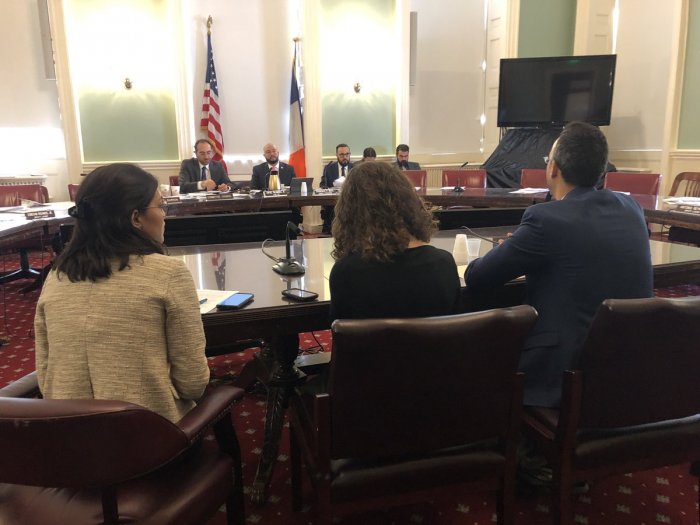
Pratt Center
Oversight on City Environmental Quality Review (CEQR) process

Thank you for the opportunity to testify. My name is Elena Conte, Director of Policy at the Pratt Center for Community Development. In our extensive experience supporting low-income and communities of color in urban planning, we have encountered many of the shortcomings of the city's environmental review process, and witnessed the ways these technocratic exercises have supported and advanced direct harm in communities.
There’s nothing wonky about the documents that dress wolves in sheep’s clothing, and become the repeated basis for decisions that exacerbate inequality and rob communities of the physical and social investments that they need to thrive.
The shortcomings of City Environmental Quality Review process (CEQR) are extremely detrimental in several fundamental ways.
First, they set up unreasonable expectations and provide false information to decision makers who are considering the merits, impacts, and ways to mitigate a proposed project.
Second, even when a significant adverse impact is found, suggested “mitigations” are not required to address the impact in any meaningful way, mitigations are not required to be instituted, and there are no funding or accountability mechanisms to ensure commitments come about or, in the future, to measure whether the issue has been addressed.
Yet for all the obvious harm of these grave flaws, they become all the more maddening because of the larger failings of our current planning system. Because the CEQR process is detailed and produces a long report, this creates the guise that it is accurate and thorough, and this is often used as an excuse not to provide communities with kind of planning analyses and follow-up activities that they are truly seeking. In turn, communities place major significance on the review process because it is the only “official” one made available to them. But the manual provides far from a complete look at what’s important; for example, in its 833 pages, “race” is avoided almost entirely, save for its mention of the State’s definition of environmental justice and a prohibition against survey bias.
This hearing is a vital first step to creating the type of rigor and accountability in the environmental review process that is necessary in an honest process, and the Intros that are being heard today (1487, 1523, 1531) are important conversation starters that point to three key areas where the guidance in the technical manual is deficient – measuring secondary residential displacement risk and impact, transportation effects, and accounting impacts on school capacity. Intro 252 elaborates on important questions that were unaddressed when the Neighborhood Commitment tracker was heard as Intro 1132 in June 2016.
We have done an extensive exploration of the ways that the guidance of the Technical Manual belies logic and common sense to erase the vulnerability of those facing significant residential displacement risk through loopholes and assumptions. Building on the work of Renae Widdison to articulate these flaws, we further examined eight Environmental Impact Statements (EISs), conducted as part of rezoning actions from 2005 – 2018, spanning the Bloomberg and de Blasio administrations, to see how the guidance was applied. We found widely inconsistent results, with a “significant impact” rarely being found. In the instances where it was found – Greenpoint-Williamsburg and the Columbia Expansion – the scale of the impacted population identified was less than 3,400 people, while in other instances, such as East New York, the number of vulnerable people was identified as more than 49,000 but dismissed as being insignificant; in still other neighborhoods, (Inwood, East Harlem, Far Rockaway) the number of people at risk was never quantified at all.
As a follow up to this work, we have performed a deep dive into the methodology for assessing commercial displacement risk. Similarly, we find tremendous gaps related to the functions businesses serve in neighborhoods and as employers, complete avoidance of consumer differences, and an inaccurate conception of industry clusters function. For our forthcoming publication, we examined twelve EISs dating back to the Downtown Brooklyn rezoning, including Greenpoint-Williamsburg, Gateway in the Bronx, Gateway in East New York, Willets Point, and more recent ones such as Inwood and Jerome. What we learned here is that none of the EISs concluded that there would be any displacement impact – direct or indirect – on businesses. In fact, we believe that there has never been an EIS that has found a business displacement impact. The “methodology” here appears to be an elaborate exercise designed to declare that there is no impact, and therefore that no scrutiny should be paid to the way that land use actions affect economic activity or policy.
These two pieces of research illustrate some of the egregious ways that the CEQR review paints over the impacts of rezonings – but the flaws in the methodologies in the Socioeconomic Conditions section of the manual are just one illustration of the larger issues across the manual. Many of the sections of the manual perform the same function – glossing over impacts so as to facilitate approval, robbing decision-makers of the tools needed to properly assess projects and create public policy. At a minimum, sections that are well overdue for overhauls include: school sites, transportation, open space, climate change, public health, and the overall consideration of environmental justice.
The question for today is not what is the best methodology for any given section, but rather how to we change our systems to incorporate the wisdom of the public, and how we develop the forecasting, measuring, and accountability tools that can provide us with shared information from which we can learn and create policy.